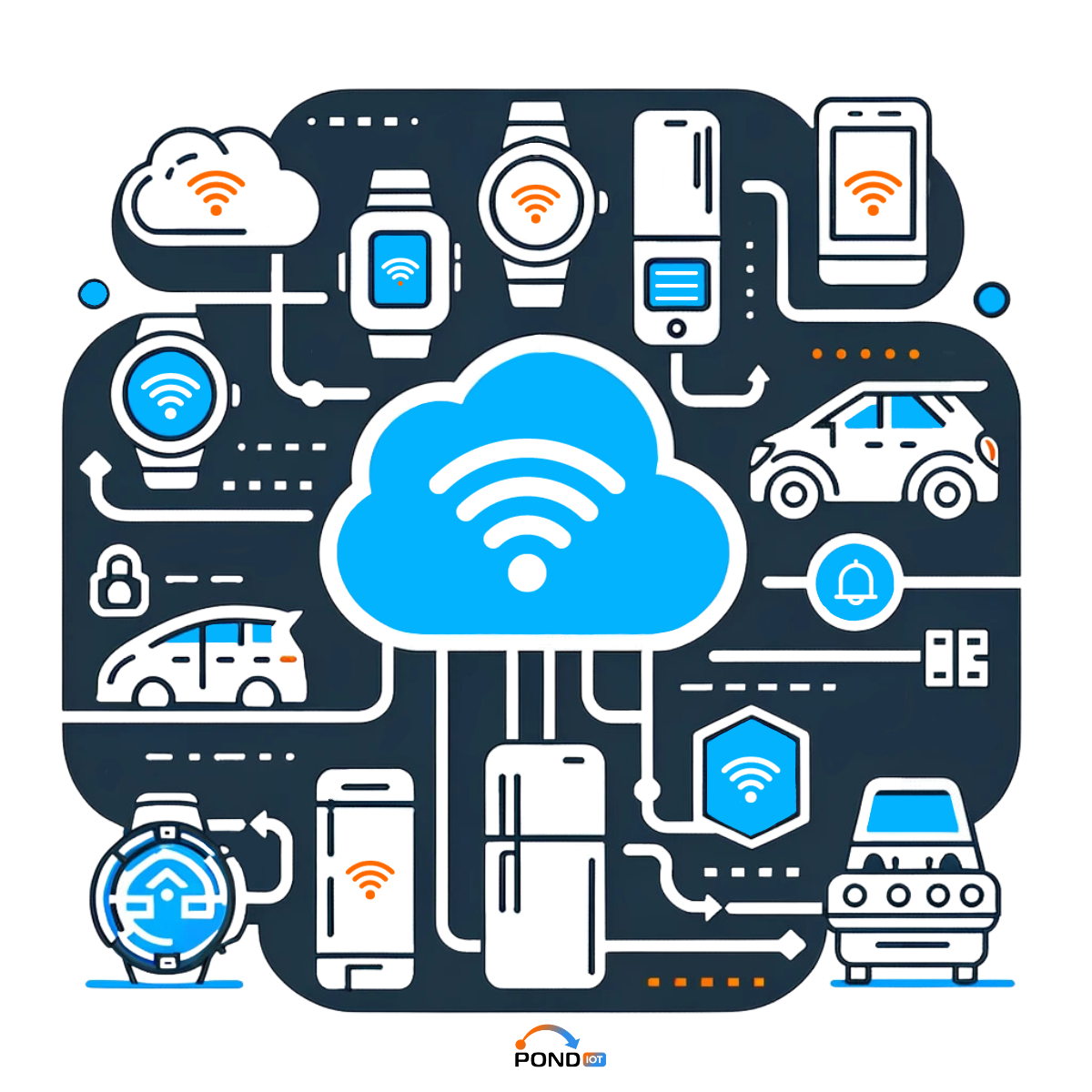
Internet of Things:
Everything You Need to Know
What is the Internet of Things?
The Internet of Things, or IoT, is like a big network where everyday objects can talk to each other over the internet. Imagine your coffee maker chatting with your alarm clock, so your coffee is ready by the time you wake up. It's all about connecting devices to make life easier and things more efficient.
Here's how it works: Devices have tiny computers in them, called sensors, that collect information from the world around them. They send this information over the internet to other devices or to people, who can use the information to make decisions or control other devices.

For example, in a smart home, the thermostat can sense when it's too cold and tell the heating system to turn on. Or in a factory, machines can send alerts when they need maintenance before they break down, saving time and money.
With the upcoming 5G internet, which is faster and can handle more devices at once, IoT is expected to grow even more. It's estimated that by 2025, there will be over 75 billion IoT connected devices around the world.
IoT is not just for homes and factories; it's everywhere! It's in healthcare, helping doctors monitor patients from afar; in cities, helping manage traffic and reduce pollution; and in farms, helping farmers keep track of crops and animals.
The cool part is that IoT can work with other new technologies like edge computing, which processes data closer to where it's collected, making everything work faster and better.
So, by stepping into the world of IoT, we're making our lives smarter, easier, and more connected!
Smart SIMS For IoT
SMART SIMs, standing for Subscriber Identity Module, are a newer, smarter breed of SIM cards specially designed for IoT devices to keep them connected across different network providers and across borders. They play a critical role in ensuring a seamless communication among IoT devices, making the management of these devices much more flexible and secure compared to traditional SIMs.

Multi-IMSI Connectivity for Cellular IoT
The landscape of Internet of Things (IoT) connectivity continues to evolve at a remarkable pace. The transformation from traditional methods of connectivity to more advanced, versatile solutions has been not just a technological leap, but a necessity driven by the demands of a rapidly changing world.
-1.png?width=300&name=Multi-IMSI_1200x1200%20(1)-1.png)
IoT Across Industries
Point of Sale (POS):
- Seamless Transactions: SMART SIMs ensure uninterrupted connectivity for POS systems, facilitating seamless transactions and real-time inventory updates.
- Data Analysis: The data collected through IoT connectivity, managed by SMART SIMs, helps in analyzing customer behavior and streamlining operations.
Healthcare:
- Remote Patient Monitoring: SMART SIMs enable secure and continuous data transmission from wearable and implanted medical devices to healthcare providers for remote monitoring.
- Telemedicine: Reliable connectivity facilitated by SMART SIMs is pivotal for telemedicine consultations, ensuring clear communication between patients and healthcare professionals.
Construction:
- Real-Time Monitoring: SMART SIMs provide the connectivity backbone for real-time monitoring of construction sites, ensuring safety and project adherence to timelines.
- Equipment Tracking: IoT connectivity allows for tracking and monitoring of construction equipment, minimizing theft and downtime.
Waste Management:
- Optimized Collection Routes: SMART SIMs enable real-time data transmission from waste bins and collection vehicles, helping in optimizing collection routes.
- Operational Efficiency: Continuous connectivity ensures efficient operations and timely reporting, aiding in resource allocation and scheduling.
Agriculture:
- Precision Farming: SMART SIMs ensure reliable connectivity for sensors monitoring soil conditions, weather, and crop health, facilitating precision farming practices.
- Livestock Monitoring: Real-time data transmission enabled by SMART SIMs helps in monitoring the health and location of livestock.
Transportation:
- Fleet Management: SMART SIMs provide the necessary connectivity for real-time tracking and monitoring of vehicles, improving fleet management.
- Traffic Management: IoT connectivity, facilitated by SMART SIMs, aids in smart traffic systems that manage traffic flow and reduce congestion.
Energy: - Smart Grids: SMART SIMs are instrumental in connecting sensors and control systems in smart grids, ensuring efficient energy distribution and real-time monitoring.
- Predictive Maintenance: Reliable connectivity enables predictive maintenance of energy infrastructure, reducing operational costs and ensuring continuous service.
Smart Cities and IoT
Smart cities showcase the full potential of IoT. They use a network of connected devices and systems to improve city life. This blend of IoT and smart city efforts leads to enhanced public services, smarter use of resources, and steps towards a greener future..jpg?width=300&name=Smart_City%20(1).jpg)
Edge Computing and IoT
Edge computing and IoT together make smart devices work faster and better:
-
Quick Decisions:
- Edge computing lets smart devices make instant decisions without waiting for data to travel far.
-
Less Waiting:
- Data gets processed close by, so IoT devices respond faster.
-
Saving Bandwidth:
- Only important data is sent over the network, keeping things smooth.
-
Working Offline:
- IoT devices can work well even without a constant internet connection.
-
Better Privacy:
- Your data can be processed locally on your device, making it more private and secure.
5G and IoT
5G technology brings a new dimension to the Internet of Things (IoT). It offers faster, more reliable connections, making IoT devices like smart home sensors and industrial machines even more efficient and responsive.
The Future of IoT with 5G
With 5G, the potential of IoT expands significantly. This combination promises enhanced real-time data processing, paving the way for advanced applications in smart cities, healthcare, and beyond.
5G's Role in IoT Growth
As IoT devices proliferate, with an estimated 75 billion connected by 2025, 5G is crucial for managing this vast network efficiently. It ensures seamless connectivity and supports the increasing data demands of a connected world.
IoT Statistics
-
Global IoT Device Count:
- As of 2023, there are 15.14 billion IoT-connected devices globally, with Greater China leading, and the count is projected to reach 29.42 billion by 20301.
-
Market Value:
- The global IoT market valued at $662.21 billion in 2023 is expected to escalate to around $3.3 trillion by 2030, with 871 million smart home devices shipped in 2022 alone2.
-
Growth Rate:
- Global IoT connections saw an 18% growth in 2022, totaling 14.3 billion active endpoints, and are expected to grow by 16% in 2023, reaching 16.7 billion active endpoints3.
-
Regional Spending and Industry Revenue:
- APAC is projected to contribute to one-third of IoT spending in 2023, with IoT industry value predicted to cross $1 trillion by 2024, and notable revenue growth expected in manufacturing, health, and social care, and electricity & gas sectors by 20304



.jpg?width=300&name=YouTube_cover_Multi-IMSI_SIMs_2%20copy%20(1).jpg)
.jpg?width=300&name=Edge%20Computing_2%20copy%20(1).jpg)